- Bernard Preston homepage
- Legumes
- How to Grow Peas
How to grow peas
How to grow peas is for all gardening lovers; with some soup and salad recipes thrown in. It is the only way to enjoy them if you want these beauties to taste sweet and tender. Within a day of being harvested nearly a half of the sugars are lost and they're a lot less exciting.
Take a little blinded-test. Ask an independent person to serve you.
- Freshly-harvested raw young peas.
- Freshly-picked and podded young peas that have been lightly boiled.
- Young peas, if you can find them from the greengrocer, again lightly-boiled.
- Frozen-peas.
Which
is your favourite? Obviously you will know which are the raw peas but
how do the others compare? It's chalk and cheese.
Even after harvesting your vegetables are still living things; cell-activity continues burning up those sweet sugars that make fresh produce so desirable.
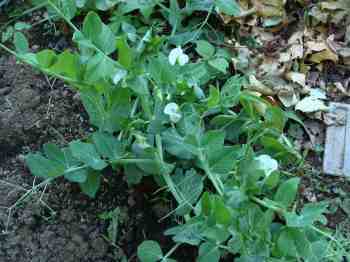
This page was last updated by Bernard Preston on 9th January, 2025.
Peas have a very low glycemic index; these are slow-release sugars that will not give you a surge in blood glucose. Frozen, the GI is considerably higher but still good at 39. However they do have quite a lot of starch so in the context of the whole meal the amount needs to be limited if you are struggling with prediabetes as I was; especially if you are also having potatoes from cold storage.
Always take a short walk after any starchy-meal; don't head straight for the TV, car or computer.
It is early Spring again in the cycle of life, my 77th-orbit of the sun. I have started turning the sod, adding
compost and getting everything ready for the first row of peas. In a mild climate you can plant them in late summer too.
The late summer planting of peas was a great success last year; and we enjoyed them every day in our Eggs Hilton for breakfast. They are wonderful addition to the Florentine dish and in a green-salad for lunch too.
This page was such a success last autumn but alas I have just noticed that
I never got to the split-pea soup recipe in the winter; that's fixed.
Today we look at how to prepare them; and why is that you may ask?
Because fresh green-peas from your garden are so much tastier. Yes, it takes time. I make no apology; you can either turn off the TV and get into the garden or eat dull and flavourless supermarket vegetables.
Or eat red-meat for your main source of protein and risk your wellbeing. How to
grow peas in a back corner of your garden is part of the recipe for a
full, long and vibrant life. Just read about the Blue Zone people; they are inspirational. They are not vegetarians but most of their amino acids come from legumes.
Do you too not want to sit under the shade of that favourite-tree you once planted and watch the young people spring up? It is so easy to sow peas, lettuce and spinach; and rewarding.
A great sadness
I have been following the saga of a favourite patient's daughter. When three-months pregnant with her second child, she got a breast malignancy. The poor woman went through the whole medical saga of amputation and chemotherapy.
Last week granny tearfully told me that she is to be a mother
again; two tiny grandchildren have become her responsibility. Her daughter has passed away; she was only 33-years old.
Research in a top medical Netherlands academic hospital concludes that the Holland has the highest rate of breast malignancy in the world. And it is directly caused by too much animal-protein; especially processed red meat.
So will you not join me this summer by planting a couple of rows of green-peas in the garden?
Type "breast cancer and prevention" into Site Search; the subject should be in the back of every woman's mind. It does not just happen to others; one in nine ladies.
How to grow peas
Knowing how to grow peas is important because they are rich in vegetable protein and anti-tumour phytosterols; straight from the garden before the sugars have been turned to starch they will enrich any salad or dinner dish. We often add a handful to our Eggs Florentine breakfast too.
You have a choice now between several varieties.
- Climbing sugarsnap-peas
- Climbing (pole) ordinary-peas
- Bush-peas like Greenfeast
My choice every time would normally be for a climbing variety but the seed for a bush-pea like Greenfeast is far cheaper; and they are much sweeter. The Sugarsnaps you can eat pod and all, a big advantage with no shelling; or a climbing variety that you put in trellis work.
Climbers are far less work, with less bending but you do have to make a trellis or fence. It's worth the time putting it in. You will use it in the summer for pole beans.
But despite the above the Greenfeast bush pea remains our favourite.
A bamboo trellis works very well for pole-beans and also for peas, if you leave the thin branches intact. I used to think a fence was better but it means growing them in the same soil each year; crop rotation is more difficult.
The trellis should for best result run North-South so the peas get sunshine from both directions. They tend to get mildew; they need full light on the two sides of the fence.
Extra fibre
Sugarsnap are a hybrid; the seed will cost you a lot more. But not having to spend laborious hours podding the peas makes it worth the extra-cash to my mind as an alternative; we grow both. There is an added benefit from the extra fibre[2].
Only 5% of those eating typical grocery store food are getting the recommended daily allowance; bowel diseases are rampant.
There is nearly 5 grams of fibre in a cup of cooked green peas; and even more when you eat the whole pod. Aim for 35g per day.
Compost
Peas are heavy feeders but being legumes they also put a lot of nitrogen back into the soil for your next crop; especially if you inoculate the seed with rhizobia. So if you want tasty, nutritious fruit dig a trench. The deeper the better.
Half fill the trench with compost and cover with at
least soil to lessen the damage done by cutworms.
You can heap it up; we let the hens scratch for a few days to peck out any grubs.
That's a lot of work. Better still is a handful of vermicompost with each seed; from the worm farm.
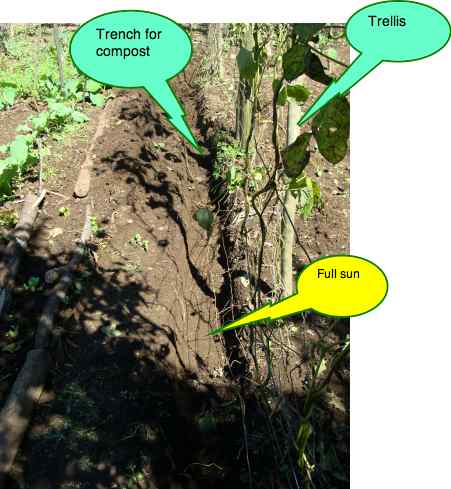
You should not follow one crop with a similar one. So, if you planted pole-beans on the trellis last summer, then dig the trench on the opposite side for your peas.
I make no apologies for the untidy patch and crooked-lines. The peas will not taste any different. You either have what I call Windsor Castle gardening, with three horticulturists and a dozen serfs, or you and I do the work ourselves.
I do not mind being the pariah with a few weeds showing and a crooked-line in my How to Grow Peas manual, because I know just how tasty and nutritious they are going to be straight from the garden; before the sugars have turned to starch.
Prince Charles
and I are about the same age, I have always felt a kinship and not a
little sadness for him; who would want to be a monarch? And now he has that burden on his shoulders. Not I, said the little red
hen. Nope, I would not swap our lives for all the tea in China; I would far rather be
the pauper and enjoy a bit of dirt under my nails now and again, than be "lapped in silks and satins." Have you ever
read that delightful yarn by Mark Twain?(1)
It is on-line and free and altogether better than Stones in my Clog, I
confess; oh for the pen of Twain but my stories are true and lot more relevant. The Prince and the Pauper is marvellous entertainment but just a thought-provoking myth.
How to plant peas
The seeds of legumes are often difficult to grow; we routinely place them on a shallow cardboard-tray, between two layers of of damp newspaper. Keep them moist in a warm, dark spot; four or five days is needed to initiate the germination.
Plant the seeds about 5 - 10cm apart and about 1/2"
deep; I have to please everyone. I wonder what Mark Twain would say
today about people who still work with feet and inches.
How many
yards are there to a mile, I cannot remember but I do know there are 1000m in a kilometre. Cover with soil, lightly pressed down; how to plant peas is not higher-mathematics.
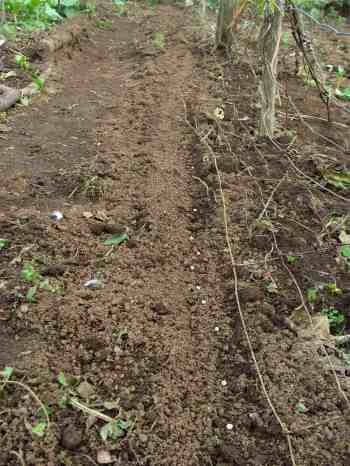
If you keep free-range hens, make sure they are confined to quarters whilst you are planting peas; they do not eat the pods with much enthusiasm, like they will attack green beans but they will scratch out your seeds.
The plus side is that cutworm attack is minimal; the hens just love them.
- Definition of cutworm, one of the most destructive creatures of the earth.
They can destroy a whole row of sprouting peas.
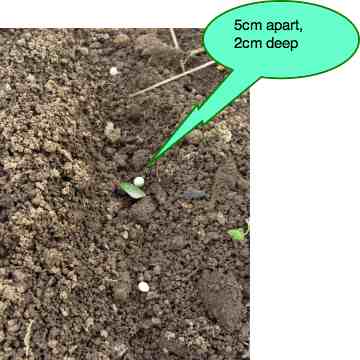
Protein in Legumes
The protein in legumes is a must for every family, vegetarian or not. Whether it is the hormones in beef or red meat per se, I am unsure but organic fare is very difficult to get. Especially the processed pork delicates like bacon and ham are strongly associated with malignant neoplasms; keep them for high and holy days.
The only solution for those who want to reach a vigorous-eighty and even ninety with their breasts and prostates intact is more legumes which are high in protein.
Broad beans are the richest in protein after soybeans, by the way and have the distinct advantage of copious quantities of L-dopa, a must for those who have a tremor. But they are awful unless young and freshly harvested.
Do you know about the amino-acids in legumes? Type "lentil protein" into Site Search.
And likewise type "vegetables high in protein."
| FOOD | Protein in 100g |
| Green podded peas | 5,42 |
| Dried Split peas | 24.55 |
| Boiled Split peas | 8,34 |
| Green pole beans | 1.89 |
| Dried kidney beans | 4.2 |
| Dried Chickpeas | 19.30 |
| Canned Chickpeas | 4.95 |
| Hummus | 7.90 |
| Dried Lentils | 25.8 |
| Raw Ground beef | 21.4 |
| One egg | 12.58 |
The pea is under attack from the keto fraternity; undeservedly in my opinion. Yes it contains considerable carbohydrate and sugars but because of its protein and fibre content, it has a very low glycemic index; that means that it does not activate the fat storage enzyme called insulin in the same way as other starches like potatoes and white rice do.
Much of it passes through the small intestine undigested. Nevertheless the obese must limit all starch, even the good ones like fresh, young peas to under 50 grams per day; or suffer a lot of pain, disability and a premature death.
Read more about resistant starch as it's known.
There's only 5g of carbohydrate in a quarter-cup of shelled green peas, a typical serving; a third of that is fibre which is resistant starch that is not digested producing sugars, but fermented in the colon by the microbiota to form important short-chain fatty acids.
So 3g of digestible starch that will form glucose is small beer if you are aiming at less than 50 grams of carbs per day.
Plus the green pea contains omega 3, the anti-arthritis fatty acid; and plenty of fibre to protect you from you know what.
Take what is clearly useful from the latest fad that you may be following but when they start to tell you avoid apples and peas because of their starch and avocados due to their fat content, then ignore them; in fact it places the whole diet under suspicion because it is not based on well accepted scientific-facts.
There is very powerful scientific research confirming how nutritious these foods are; we omit them from our regular meals at our peril. But the chocolate cake must go obviously; only for high and holy days.
Newsletter
Our newsletter is entitled "create a cyan zone" at your home, preserving both yourself and Mother Earth for future generations; and the family too, of course. We promise not to spam you with daily emails promoting various products. You may get an occasional nudge to buy one of my books.
Here are the back issues.
- Lifestyle and ideal body weight
- What are ultra-processed foods?
- Investing in long-term health
- Diseases from plastic exposure
- Intensive lifestyle management for obesity has limited value
- A world largely devoid of Parkinson's Disease
- The impact of friendly bacteria in the tum on the prevention of cancer
- There's a hole in the bucket
- Everyone is talking about weight loss drugs
- Pull the sweet tooth
- If you suffer from heartburn plant a susu
- Refined maize meal and stunting
- Should agriculture and industry get priority for water and electricity?
- Nature is calling
- Mill your own flour
- Bake your own sourdough bread
- Microplastics from our water
- Alternative types of water storage
- Wear your clothes out
- Comfort foods
- Create a bee-friendly environment
- Go to bed slightly hungry
- Keep bees
- Blue zone folk are religious
- Reduce plastic waste
- Family is important
- What can go in compost?
- Grow broad beans for longevity
- Harvest and store sunshine
- Blue zone exercise
- Harvest and store your rainwater
- Create a cyan zone at your home
These figures are in some ways distorted. You would battle to eat 100g of lentil-protein but the same weight of ground beef or an egg at a sitting is not unrealistic, of course.
My point is simply that the whole gamut of legumes are rich in protein, nearly comparable with the amino-acids from eggs and meat.
Those that are dried appear to be richer in vegetable protein because the water has dried off, but do not underestimate the green pea for example. You could with a bit of enthusiasm enjoy 100g of them, but would be hard-pressed to swallow them dried and split in a soup.
Lentils, garbanzos and split peas are the richest in vegetable protein; and our much loved but difficult to get fava-beans. Try to eat at least one of them every day. Yes, daily, if you want to escape the nasty lurgy.
A seed is a wonder of nature. I find it mind-blowing that you can drop a shriveled up pea into the ground and 10 days later, astonishingly find this little miracle shooting up.
How to grow peas brings you right into the Garden Cathedral where Adam and Eve first encountered our God. You might too.
- Growing butternut squash
- Authentic hummus recipe; I can make it in four minutes flat from frozen chickpeas.
- Plant lettuce too.
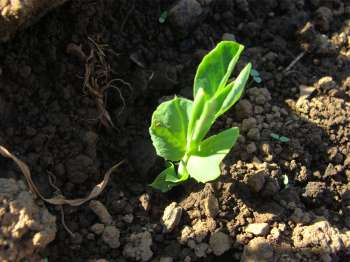
And now it is time to reap the rewards of your hard work. These are Sugar Snap climbing peas; you can eat the pod too, either raw or very gently stir-fried.
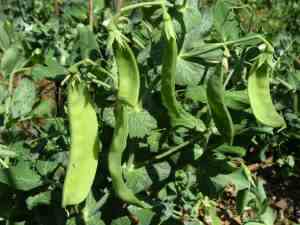
Green pea salad
As per usual, I hate precise and restrictive recipes. Do you not find they stifle the creativity in you? And if you omit the celery today, is it a train-smash?
INGREDIENTS
- Two cups of recently picked and podded green peas
- A finely chopped shallot
- A finely sliced red or yellow bell pepper
- Half a cup of broccoli florets (and if possible some of the bright yellow flowers)
- A cup of sliced celery
- Half a dozen radishes.
- A handful of very finely chopped parsley.
- Homemade olive oil + lemon juice dressing.
- Half a cup of yoghurt.
- A good handful of nuts and seeds. My favourites are the pecan and sunflower.
METHOD
- If the peas are from your garden, just pod them and toss them in raw. If bought and young, briefly steam them together with the broccoli florets for a 2-3 minutes. Longer if they are older. Drain, keeping the water.
- Meantime make up a bed of lettuce and rocket in your favourite pretty bowl.
- In a mixing bowl, chuck in the celery, shallot and nuts and seeds. Add the yoghurt and a teaspoon of raw honey if you know a local beekeeper. Bought honey is not worth having. Mix them up. A shake of S&P, freshly ground.
- Dump the steamed peas and broccoli florets on the lettuce, pour salads and yoghurt mix.
- Arrange the thinly sliced peppers and radish prettily, sprinkle the parsley thickly, and finally the raw broccoli flowers. They are not just a garnish, delic.
- Let your guests add the olive oil, freshly-squeezed lemon juice and a little of the left over pea water from a decanter.
- Let your green pea salad recipe chill for half an hour whilst you chill out with a glass of red wine.
How many will it serve? How long is a piece of string? Come on, you have been cooking long enough to guesstimate. It depends on what else you are preparing but rather serve more of your pea-salad recipe; and then a small helping of roast beef, new potatoes and butternut, of course.
If you are not up to date on the virtues of new potatoes, by the way it's time to investigate; they have far less starch. They are not likely to disturb your blood glucose unduly.
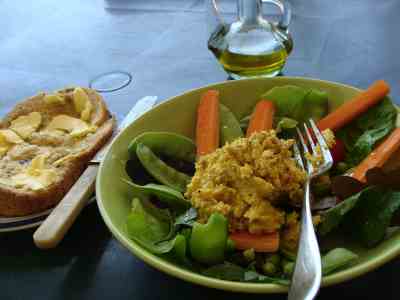
Notice the Sugar-Snap that you can eat pod and all, and the shelled peas, both picked no more than fifteen minutes ago in the garden. The taste is divine, unbelievably sweet. You will never get to enjoy this kind of food unless you make time for the backyard.
And really how to grow peas is not just for folk with a green-thumb. Only beans and radish are easier. Pop in a seed; two months later tuck in.
I am glad I know how to grow peas. Last week, being autumn I dropped about 50 seeds in the ground, first having soaked them on wet newspaper for a few days; they are reluctant to germinate sometimes.
Usually there would be a chunk of feta cheese or half an egg with this lunch, by the way; perhaps a few slithers of salmon.
And they go on bearing for many weeks.
Adding your own homemade nutritious hummus recipe really makes any salad. Rustle it up in four-minutes; notice, too, that you can indulge in real butter on your bread if you are eating these kinds of foods.
Nitrogen Fixation Bacteria
The natural nitrogen in the soil, absolutely essential for the plant and animal kingdoms including ourselves comes from two main-sources; lightening and bacteria that attach themselves to the roots of legumes. Knowing how to grow peas enriches your garden as well as your own body.
These bugs are able to fix the nitrogen in the air and make it available to other plants for growth. Inoculating rhizobia onto legume seeds will greatly improve your crop; it's simple. That is what enables them to synthesise vegetable protein.
How to grow peas is central to rich garden soil full of the nutrients needed by all your other vegetables.
Broad-beans and peas use the same rhizobia, by the way. The bacteria watered onto the ground will double your crop.
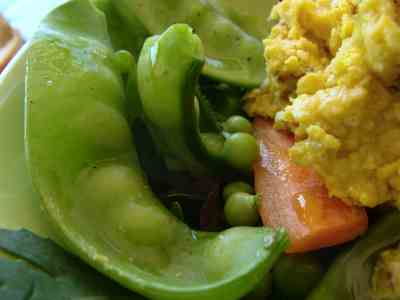
Any crop that follows a legume will bloom from the nitrogen these little friendly bacteria leave behind in the soil.
Read more about nitrogen fixation bacteria.
Protein in peas
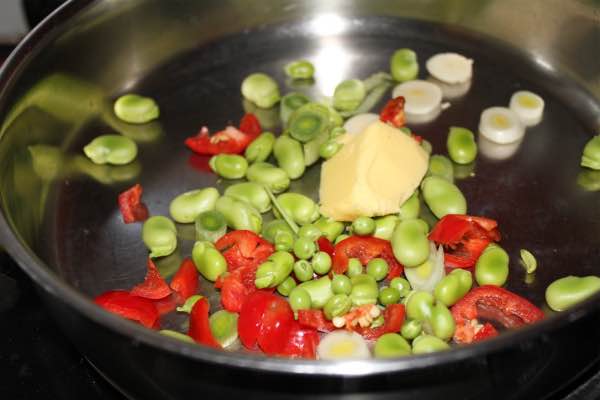
Fava beans and green peas are the start of Eggs Hilton; this dish gives a sense of satiety like no other breakfast I know. It deals with my mid-morning hunger pangs; no more reaching for a cookie or cola.
Average Americans and South-Africans consume nearly a cup of sugar every single day; is it any wonder we are obese? Half of the solution is a decent breakfast that will provide satiety. We do not eat nearly enough whole grains and legumes.
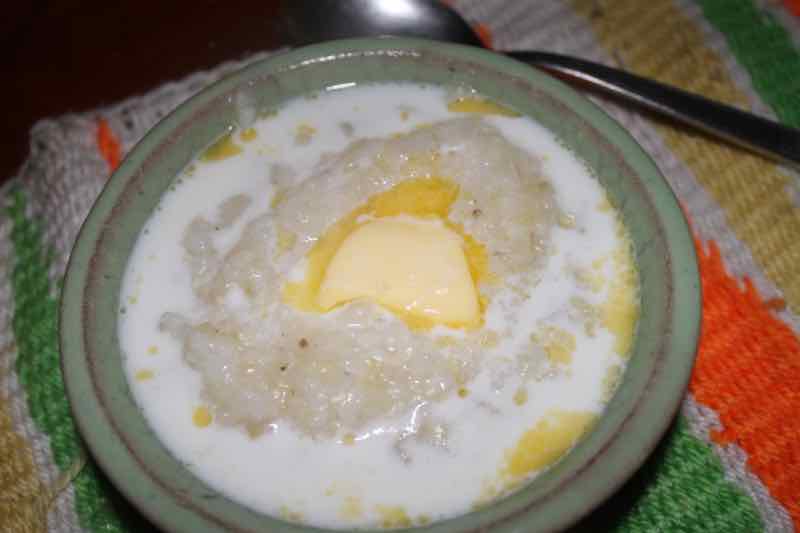
Every
day the DC is faced at the Coalface with patients suffering
from the ravages of obesity; terrible arthritis in the knees, foot pain and
diabetes. Part of the solution is the protein in peas, rather than red meat every day; and whole grains.
We follow the "flexitarian" way of eating; meat occasionally but with most of our protein comes from legumes and young cockerels from the flock.
But in the main, researchers are now finding that it's refined carbohydrate rather than fat that makes us obese; that white rice, bland doughy rolls and energy drinks.
I have at least half a dozen fresh raw green pods for lunch every day in the cooler weather. When the peas are ready for picking I have a team of granddaughters just waiting to help me shell them; only some reach the pot.
Mind you a handful tossed on "eight colors eggs Florentine" is a culinary wonder. Find it using Site Search.
Another favourite is Eggs Hilton.
My daughter took my blood pressure yesterday; 128/81 which is not bad at 76. Part of the reason at least is masses of whole foods. Not that I don't love a good steak now and then.
More legumes in your diet are part of the solution. Take a look at "High protein low fat foods" using Site Search.
Just add a few whole sugarsnap peas and hummus to a couple of our lettuce wraps recipes and you have a quick and easy nutritious lunch.
USEFUL LINKS @ How to grow peas
- Nutritious choice foods …
- Easy pesto recipe with peas; make it in ten minutes.
- Easy lunch recipes
What's potting?
What to plant and when, remembering this applies only to a temperate climate. You would not be planning how to grow peas in late summer in Chicago.
Aside:
Do these simple little lower back exercises every morning before getting out of bed and particularly on gardening days; you'll save yourself a lot of pain and money, visits to the DC and the risk of the complications of surgery. They take less than two minutes.
Knowing about good food as in how to grow peas is not enough; we need exercise too.
Truth of it, most of us with the best will in the world, all the care and exercises will occasionally have slipped disc symptoms to contend with. If it starts in the leg, do not delay. Get to your DC, remembering that if you first consult your doctor, research shows you are far more likely to end up under the knife.
Always when gardening, before learning how to grow peas I do my lower back exercises. Prevention is better than a cure.
Black eyed pea recipe
Some like it hot! I do. So there are chillies or jalapeno peppers in this salad recipe.
You'll need:
- One small onion, finely chopped.
- One red bell pepper, roughly chopped.
- A couple of shallots or spring onions, chopped too.
- Either a quarter of a red chili or two jalapenos, finely chopped.
- Four large very ripe tomatoes, chopped.
- A clove or three of garlic.
- Juice of half a lemon and a couple tablespoons of virgin olive oil.
- One can of black eyed peas and another of black beans; drained.
- A sprig of fresh coriander from your herb garden, such an easy herb to grow. A weed.
- A large handful of parsley or rocket, finely chopped.
Just toss into a large bowl, mix well and let the herbs and spices penetrate your black eyed peas recipe for a couple hours. Spread on a bed of fresh lettuce and young spinach leaves from the garden. Remove some of the chili seeds if you don't like it too hot, remembering that is where much of the capsaicin is to be found.
I've never tried it but this coming year after how to grow peas, I am going to try making this dish with fresh green peas straight from the garden.
Do you suffer from indigestion heartburn? Use rather less raw onion and perhaps parboil it; and drink plenty of fluid BEFORE your meal, not after.
Here is one more anecdote. After 15 years of bellyache after my evening meal (I have a small hiatus hernia and had a helicobacter infection) a daily dose of homemade kefir completely cured it in one week; never underestimate the importance of the normal flora in the gastrointestinal tract.
Did you find this page useful? Then perhaps forward HOW TO GROW PEAS to a fellow book or earthworm; or tweet it.
- Prince and the pauper; read it here for free.
- Sugar Snap Peas Nutrition Facts and Health Benefits
When browsing use right click and "Open Link in New Tab" or you may get a bad gateway signal.
Did you find this page interesting? How about forwarding it to a friendly book or food junkie? Better still, a social media tick would help.
- Bernard Preston homepage
- Legumes
- How to Grow Peas
Address:
56 Groenekloof Rd,
Hilton, KZN
South Africa
Website:
https://www.bernard-preston.com